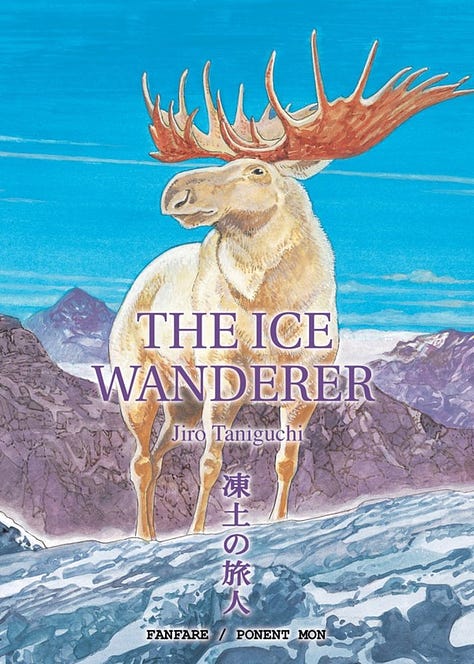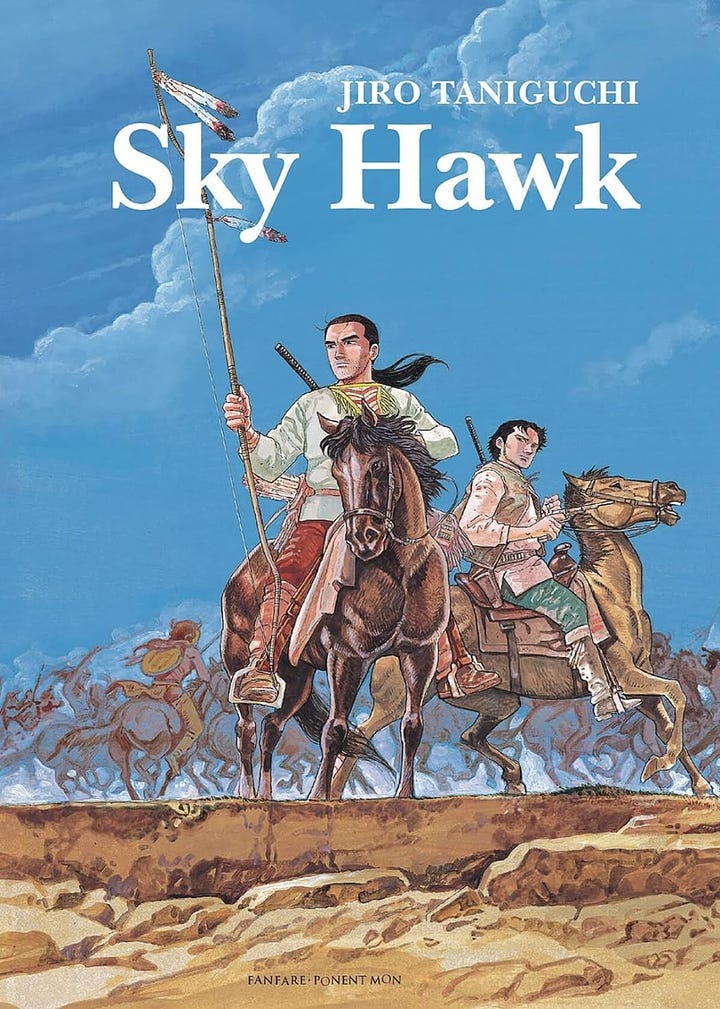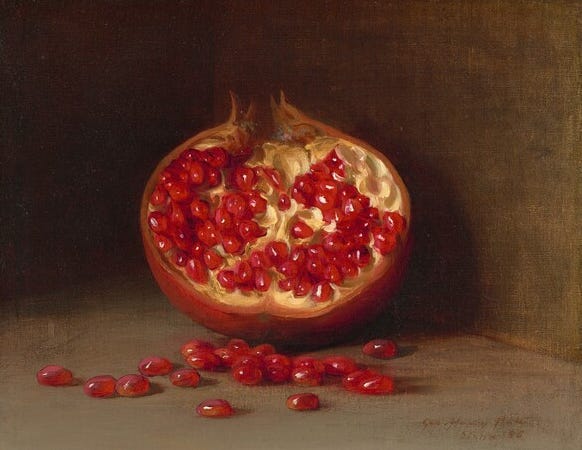#85 - The Three Modes of Jiro Taniguchi
The Three Taniguchis; Low-Effort, Meh-Reward; Stand Up-date
Hello, my friends,
It’s been quite a week! After all of my running and calisthenics over the past six months, I returned to Brazilian Jiu-Jitsu on Wednesday evening after over five years away. Unsurprisingly, I am not very good. Also unsurprisingly, my preparation paid off in my not being all that sore. I am a little sore, but functioning just fine. I’ll be going once a week and play it by ear. On off-days, I plan to do yin yoga for flexibility and calisthenics to increase my stamina.
This week also contains Sophie's and my birthdays. She is 3 and I’m 40. Good ages, both. My birthday will be pretty quiet this year, I’m taking Sophie to a doctor’s appointment in the morning and then working the rest of the day. Ashley is going to bake me a sweet treat I chose from the Pie Hole cookbook. I am very much looking forward to eating it!
And speaking of the passage of time, shana tova to all of my Jewish readers. May your year 5785 be sweet and fruitful!
The Three Taniguchis
I’ve done a fair amount of reading over the past few weeks, finishing five comic books by Jiro Taniguchi — whose work I’ve reviewed previously in this space — the delightful So Many Steves: Afternoons with Steve Martin (with Adam Gopnik), Mastering Stand-Up: The Complete Guide to Becoming a Successful Comedian, and outstanding book about stand-up comedy by Stephen Rosenfield, and Foucault: A Very Short Introduction by Gary Gutting. I just started listening to Systems Biology: A Very Short Introduction by Eberhard O. Voit and Raising LGBTQ Allies by Chris Tompkins. For the latter, I’m interviewing the author during a live virtual event later this month so it behooves me to read the book, though I’m also interested in the topic.
Taniguchi’s books seem to fit into three distinct categories: Tour books (like Venice, reviewed in #77), genre stories, and nostalgic tales (like A Distant Neighborhood, reviewed in #73). A Walking Man (reviewed in #78) seems to be the exception. Thanks to various libraries, I’ve been able to read plenty of Taniguchi in all of his incarnations. My least favorite has been Guardians of the Louvre, a phantasmagorical story of a young man on trip to Paris, whose fever dreams consist of flashbacks of various Louvre-related moments, complete with ghosts. While the drawings were in Taniguchi’s typically neat style, the stories themselves were stilted with the protagonist awkwardly shoved into historical moments with nothing to do. The most interesting moment was a return to the Louvre of WWII, with the museum’s most important works quickly and carefully transported to various safe places. In other stories, the hero encounters various artists including Vincent Van Gogh. If only their meetings were less fleeting.
Taniguchi’s genre stories The Ice Wanderer and Other Stories and Sky Hawk were more traditionally-plotted stories. In The Ice Wanderer the mangaka took inspiration from and adapted several of Jack London’s stories for the first three entries (“The Ice Wanderer”, “White Wilderness”, and “Our Mountains”). All three take place in the upper Northwest, pitting man against nature, wildlife, and other men. There’s plenty of exciting action and dangerous situations. The fourth story, “Kaiyose-Jima” (“The Island Where the Wind Brings the Seashells”) has a distinctly Miyazaki flavor, minus the imaginary creatures. When the mother of a young boy with divorced parents gets sick, he is sent to spend the summer in her rural seaside hometown where he, a cityboy, must adapt to the environment. When a boat trip with an older girl goes wrong, the adventure really begins. Next is “Shôkarô”, a seemingly autobiographical story following the awakening into life of a young mangaka during his stay at a boarding house that was once a brothel (see the more in-depth review at Morning, Roo). “Shôkarô” has some of the same appeals as A Zoo in Winter, which I’ll get to in a bit. The final story “Return to the Sea” pays poetic homage to the culture of the Chukchi people of the far North. A diver becomes obsessed with an old humpback whale, following him as he makes his final journey.
Sky Hawk is another, this time full-length, “western” genre story of two disgraced samurai who cross the Pacific and, through their courage and attention to honor, become accepted as Oglala warriors, taking part in the Indian Wars, up until the indigenous tribes are forced onto reservations. It’s a fast-moving, entertaining, story that includes historical figures and events. Initially, I was concerned that such an juxtaposition of cultures would lead to awkward stereotyping, but just as in “Return to the Sea”, Taniguchi treats indigenous people and their societies with reverence. While this wasn’t my favorite of Taniguchi’s creations, I wasn’t sorry I read it. I did read two other works, Hotel Harbour View and Tokyo is My Garden, in which Taniguchi collaborated with others. The former is several short, noir-tinged, hard-boiled tales that, to me, resembled a straight-take on Dick Tracy comics. The drawings remind me of the story “Tokyo Illusory Journey” in A Walking Man. The latter follows an idiosyncratic transplant to Japan in his attempt to satisfy his visiting European boss (which would allow him to stay in Japan). It was a rollicking city story, but not Taniguchi’s style.
When it comes to Jiro Taniguchi, I feel like his most effective work is in the nostalgic mode. To that end, A Journal of My Father and A Zoo in Winter are very satisfactory. In A Journal a early-middle-aged designer returns to his hometown following his estranged father’s death. His conversations with friends and family during the nighttime vigil lead to flashbacks that open his eyes to the unexpected feelings and experiences of others he had been unable and unwilling to see during his rash youthful move to the city (from which he rarely returned). Following the Great Tottori Fire of April 17, 1952, rifts between Yoichi’s parents eventually lead to divorce with the boy and his older sister staying with their stalwart barber father. The young boy’s sadness and shock at this sudden (to him) family change led to building resentment towards his father, which he carried until the older man’s death. Taniguchi uncovers a decades of family history in layers so both Yoichi and us readers discover his father’s true character. Though there was little suspense about the true nature of things by the middle of the book, the dramatic irony of Yoichi’s discoveries carry a poignancy that lingers.
A Zoo in Winter is a somewhat sparse mangaka memoir, unlike the hulking A Drifting Life by Yoshihiro Tatsumi (see this article for more background regarding the concurrent movement of these two artists), covering several years in the artistic and social coming-of-age moments of the Taniguchi. Though the conflicts in the beginning are relatively low-stakes, the plot eventually ties together the artist’s first love and his first manga publication into a lovely twine. Despite the abrupt ending, I really enjoyed watching the protagonist move from innocent arrival in the big city to working artist to a man driven by love. To be honest, I wish this book was as large as Tatsumi’s memoir, but alas this is not what we have.





Low-Effort, Meh-Reward
I may have mentioned this in the newsletter, but a while ago a local library was having a Korean music concert. Seeing that it would be just Sophie and me that day, I figured it would be a lovely father-daughter outing so I marked it in my calendar like a month in advance. On the day of, I got dressed and readied Sophie with plenty of time to spare — the library was minutes from our house and we arrived at 10:18a for a 10:30a concert. Wonderful! We would have time to get settled.
However, when we got the library, I realized I had made an error. The concert had actually begun at 10:00am. The front desk staff quietly directed me into the room only to find out that we arrived just as the concert was ending! I was sad, surprised, and confused in combination. How could this be? The library put on a concert that was less than 20 minutes long? Did they feel that people who made a point to come to specifically to see this program (potentially from some distance) would be satisfied with a concert of this length? What kind of low-effort activity was this??
Issue #83 of HMF was part of a Seed Pod about libraries on a newsletter called SmallStack. The idea is that a bunch of small newsletters write about the same topic and go read each other’s stuff. I did just that, reading probably 20-30 other people’s entries. Some were average, some good, some great, but I was also disappointed by the amount of entries that ranged from a few sentences to a one or two paragraphs. It’s like those people didn’t even try to create something interesting. Like they gave it little to no effort, essentially wasting the reader’s time (not a lot, thankfully).
I find this sort of low-effort fairly often with library programming. Events like adult coloring, 18-minute concerts, and children’s free play (with Lego or other library toys) make me fidgety. I wonder, is this really the best they could do? I guess adult coloring has some benefits, but does a librarian really even need to put it on? Just leave some coloring implements and sheets on the table and go about your day. A library I frequent has a passive puzzle table; members of the public can sit and work on the puzzle as they like. Why is this a passive program and adult coloring a scheduled one?
I admit that sometimes it’s like fine, whatever, low-effort can be acceptable. But it still pisses me off. Do better, people!
Stand Up-date
This newsletter is already too long, but I’ll give you a short summary of my second open mic performance last Friday. It went fairly well, friend of HMF, Joe (who very recently moved to Japan (not as a way to escape my bad comedy, mind you)), kindly came along and filmed me with my phone so I could see what I looked like on stage and listen to the laughs. And groans. And silences.
As always, it was a mixed bag in terms of performances, but I would say that the average level of talent was higher at this open mic than my first outing, partially because there weren’t the slew of awkward man-childs making bad jokes about sensitive topics. For my part, I’ll be making some cuts to my set and adding in new material for next time I perform (probably in a few weeks).
It’s still early for me to think about this since I’m very much a beginner, but I wonder what kind of character dell pickles is. What kind of jokes does he love to tell? How far does he push things? Is he straightforward or does he approach comedy from off-kilter angles? I’m always making notes of potential material and I occasionally come up with stuff that I’m both not sure I can perform and also have no idea whether it will work as comedy.
Probably dell will keep it straightforward for a while, to gain experience working with audiences in this medium, but there are some topics and performance mechanics that Ihe wants to explore. All in due time.
Time Machine
Here’s what I wrote in HMF a year ago (in issue #32):
Reading (Abstract) Poetry Out Loud for an Audience: An essay on reading poetry well in public.







I think with the adult coloring some people need the ritual of a group activity to give them 'permission' to try it, where if it was simply left out they might feel too self-conscious or uneasy about whether they're 'doing it right'. There can be a social and communal aspect beyond the activity itself.
happy new year & happy birthday to both of you!